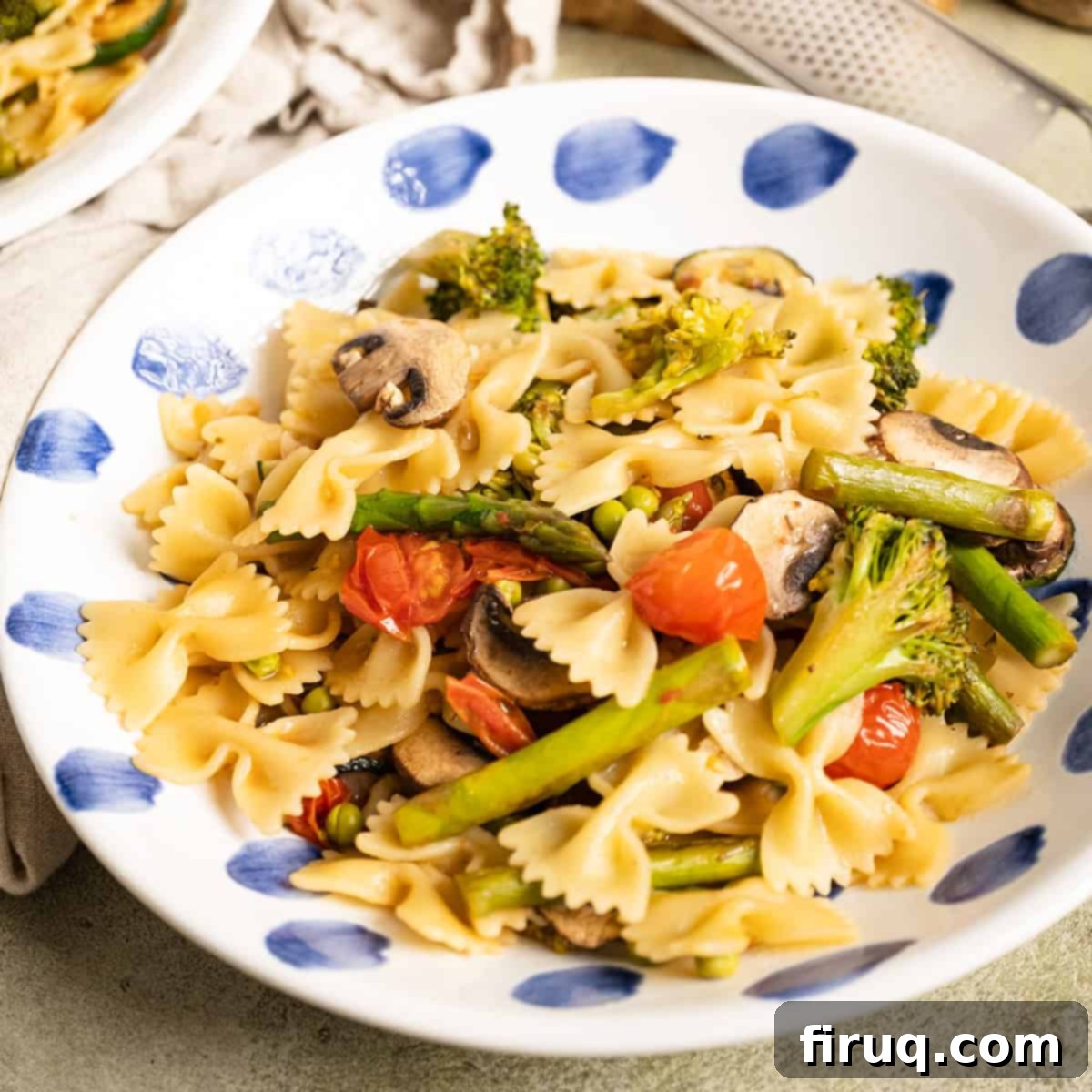Delicious Pasta Primavera with Broccoli and Asparagus: Your Ultimate Spring Recipe
Pasta Primavera with Broccoli and Asparagus is the quintessential dish for celebrating fresh, vibrant spring flavors. This simple yet incredibly delicious, veggie-packed meal comes together in under an hour, making it perfect for busy weeknights or a delightful weekend lunch. It masterfully combines tender-crisp asparagus, florets of bright green broccoli, and a light, savory garlic wine sauce, creating a symphony of tastes that truly embodies the essence of spring in every single bite.
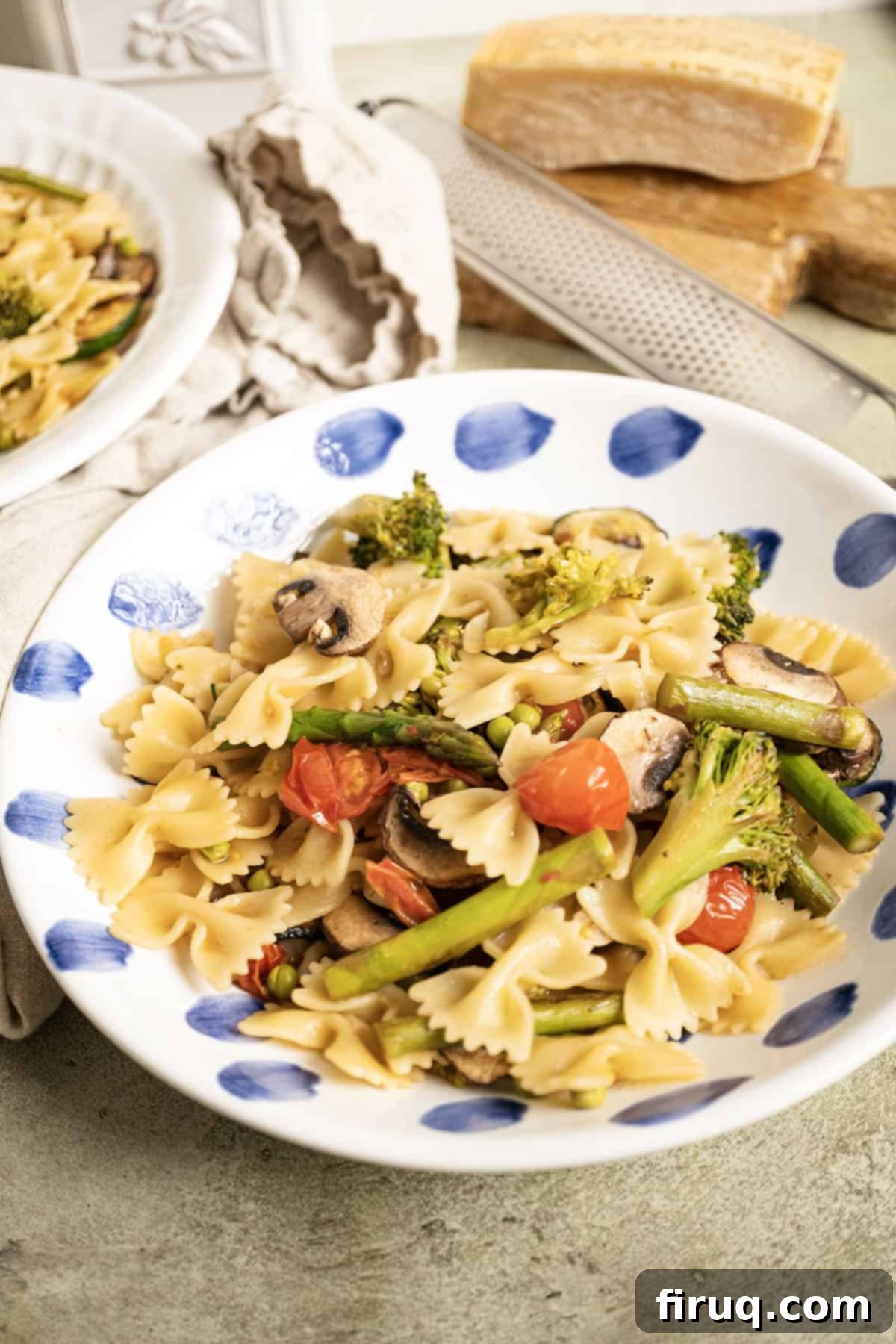
Craving more easy and delicious pasta recipes packed with vegetables? Don’t miss our Pasta with Peas and Pancetta for a touch of savory goodness or our light and refreshing Italian Summer Pasta with Zucchini.
[feast_advanced_jump_to]
Why This Pasta Primavera Recipe Stands Out
The arrival of spring signals the perfect time for Pasta Primavera. This dish is an exquisite way to showcase the season’s bounty of fresh vegetables. What truly sets this recipe apart from many others is a crucial technique: frying vegetables separately. By browning ingredients like mushrooms and zucchini independently before combining them with the rest of the dish, you guarantee tender-crisp vegetables with a beautiful golden crust. This method prevents them from becoming mushy or watery, which often happens when all vegetables are cooked simultaneously in the same pan. The key to a truly perfect primavera is ensuring that your vegetables are not just steamed but have developed rich flavor and texture through proper searing.
Pasta primavera is one of my go-to main dishes or side dishes because it ingeniously combines carbohydrates and a generous serving of vegetables into one harmonious meal. It’s incredibly versatile and pairs wonderfully with a variety of proteins. Serve it alongside your crispy Italian Chicken Cutlets or a succulent Classic Pork Chop Milanese to create a complete and satisfying dinner that will delight your family and guests.
Essential Ingredients and Smart Substitutions
Crafting the perfect Pasta Primavera starts with selecting fresh, high-quality ingredients. Here’s a closer look at what you’ll need and how you can adapt the recipe to your liking:
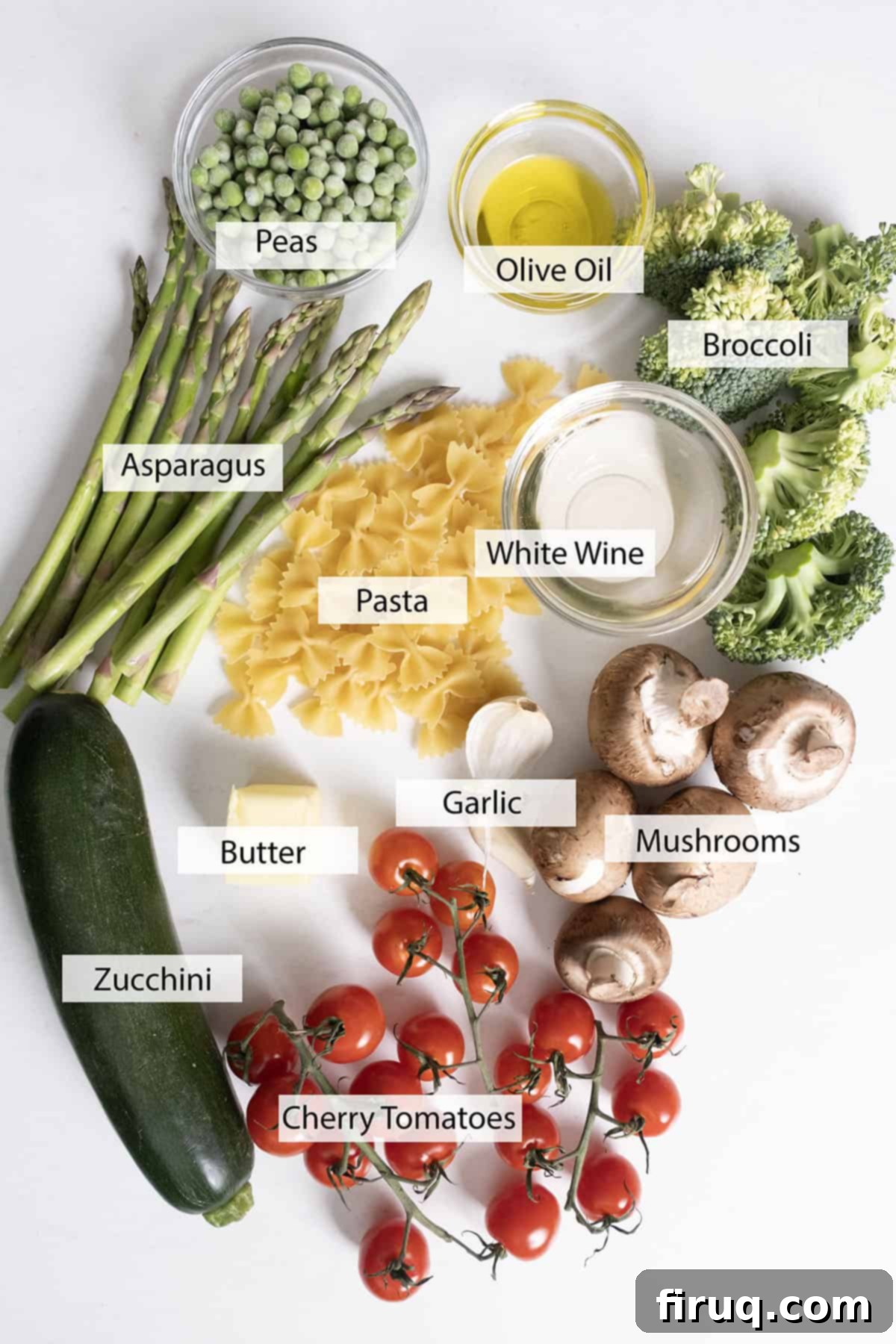
- Vegetables: Primavera literally means ‘spring’ in Italian, and the beauty of this dish lies in its flexibility to incorporate a medley of seasonal produce. While our recipe features classic broccoli, asparagus, mushrooms, zucchini, and cherry tomatoes, feel free to get creative! Other excellent additions include snap peas, green beans, bell peppers (any color), chopped carrots, or even a handful of fresh spinach or kale added at the very end. The key is to use fresh, vibrant produce for the best flavor and texture.
- Peas: For the best results, always opt for frozen peas. They retain their sweet flavor and firm texture much better than canned peas, which tend to be mushy and can impart a dull flavor to your dish. No need to thaw them beforehand; they’ll warm through quickly in the sauce.
- White Wine: A dry, crisp white wine is essential for deglazing the pan and adding a bright, acidic note to the sauce. I highly recommend a Sauvignon Blanc or Pinot Grigio. If you prefer not to use alcohol, a good quality vegetable broth with a squeeze of fresh lemon juice makes an excellent substitute.
- Cherry Tomatoes: I prefer cherry tomatoes over grape tomatoes in almost all scenarios, and definitely for this recipe. Their slightly sweeter taste and tendency to burst gently when cooked add a wonderful juiciness to the sauce. If cherry tomatoes aren’t available, small diced Roma tomatoes or even a handful of sun-dried tomatoes (rehydrated if dry-packed) can work.
- Linguine: This recipe uses linguine, which is a fantastic choice as its flat shape holds the light sauce beautifully. However, you can easily substitute with other long pasta shapes like spaghetti or fettuccine, or even shorter cuts like penne, rotini, or farfalle, depending on your preference.
- Garlic: Freshly minced garlic is non-negotiable for that authentic aromatic flavor. Avoid pre-minced garlic for the best results.
- Olive Oil & Butter: A good quality extra virgin olive oil is used for frying the vegetables, while butter is incorporated into the sauce for richness and a silky smooth finish.
- Pasta Water: Don’t underestimate the power of this ingredient! Starchy pasta water is the secret to creating a cohesive, emulsified sauce that clings beautifully to your pasta and vegetables. Always save about a cup before draining your pasta.
*Please see the recipe card below for precise measurements and quantities of all ingredients.
Step-by-Step Guide: Crafting Your Perfect Pasta Primavera
Achieving a truly delicious Pasta Primavera with perfect texture is all about following a few crucial steps. I always emphasize that simply throwing all your vegetables into the pan at the same time will result in a mushy, watery pasta dish. To avoid this common pitfall and create the BEST Pasta Primavera with broccoli and asparagus, follow these detailed steps carefully:
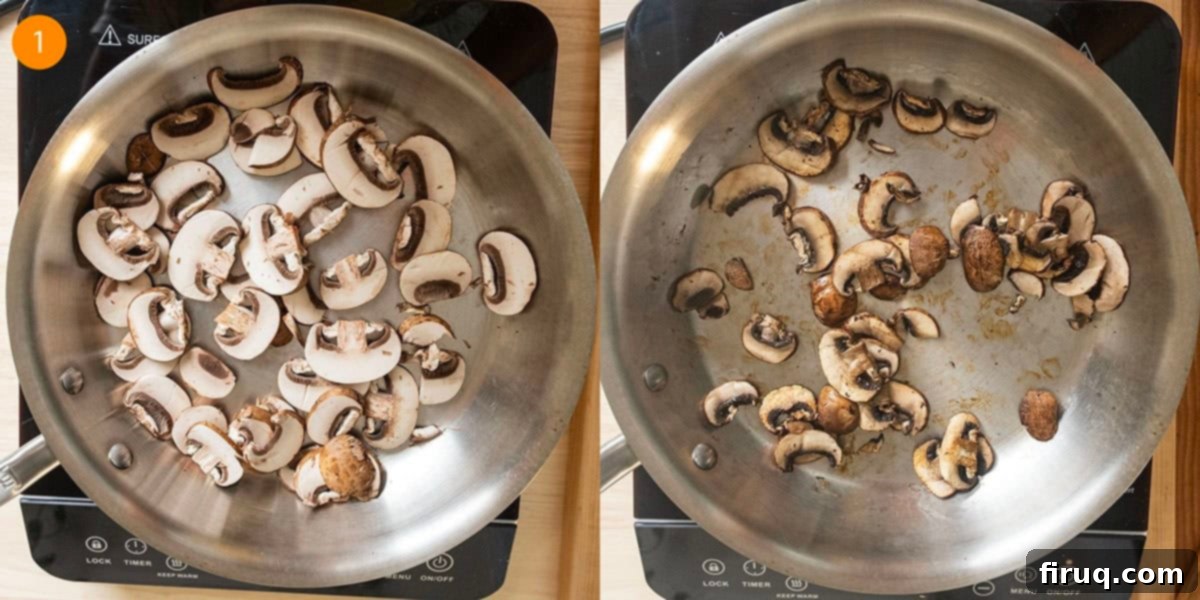
Step 1: Perfectly Brown Your Mushrooms. Heat a large saucepan or skillet over medium heat. Add your sliced baby bella mushrooms. It’s essential to let them sit undisturbed for the first 3 minutes. This allows them to release their moisture and begin to brown, developing a rich, savory flavor. Mushrooms contain a lot of water, so you won’t need any oil for this initial frying stage. After 3 minutes, stir them and continue to brown for an additional 3-5 minutes, until they are deeply golden. Remove the browned mushrooms from the pan and set them aside. This separate cooking ensures they maintain their texture and don’t make the other vegetables soggy.
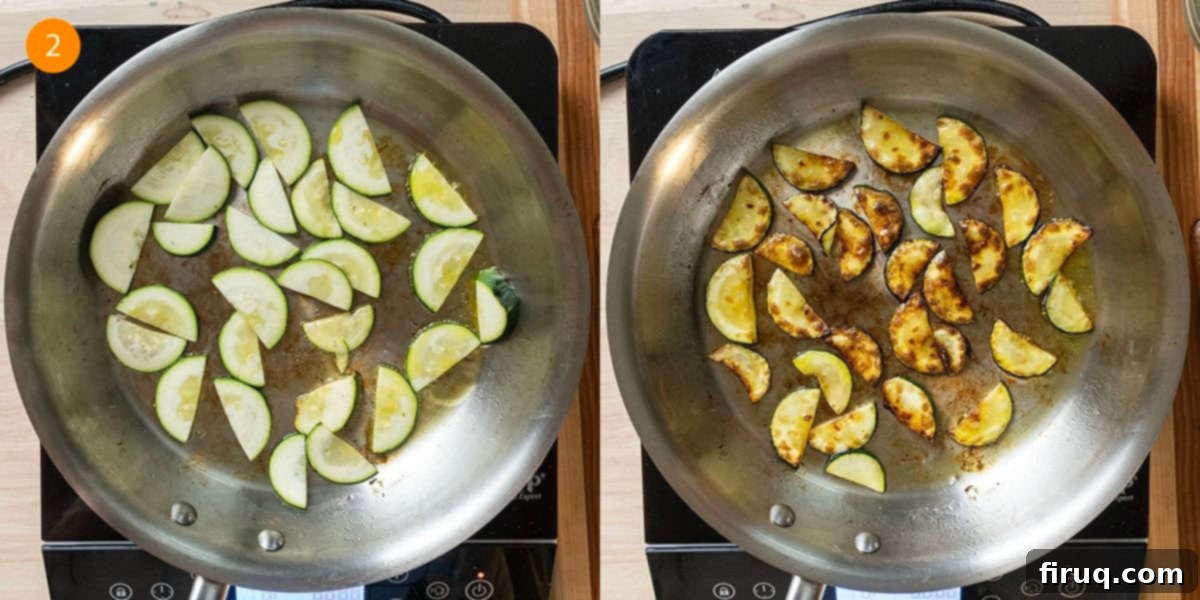
Step 2: Sear the Zucchini. Add 2 tablespoons of olive oil to the same pan. Arrange the sliced zucchini in a single layer to ensure even cooking and proper browning. Fry for 2-3 minutes on each side or until they are beautifully golden brown and slightly tender-crisp. Overcrowding the pan will steam the zucchini instead of searing it, so cook in batches if necessary. Once browned, remove them and set them aside with the mushrooms.
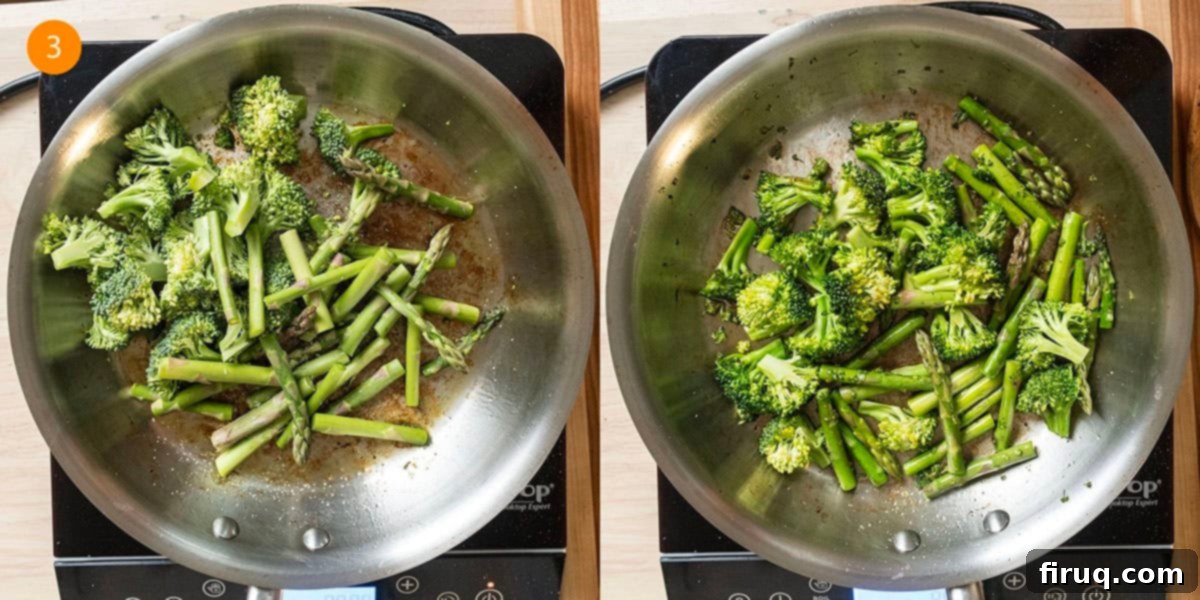
Step 3: Cook Broccoli and Asparagus, and Start the Pasta. In the same saucepan, add another 2 tablespoons of olive oil. Add the broccoli florets and chopped asparagus, tossing them to coat. Sauté for approximately 5 minutes or until they turn a vibrant green and are tender-crisp. While the vegetables are sautéing, bring a large pot of salted water to a rolling boil. Add the linguine and cook according to package directions until it’s just shy of al dente. Remember to reserve about 1 cup of this starchy pasta water before draining.
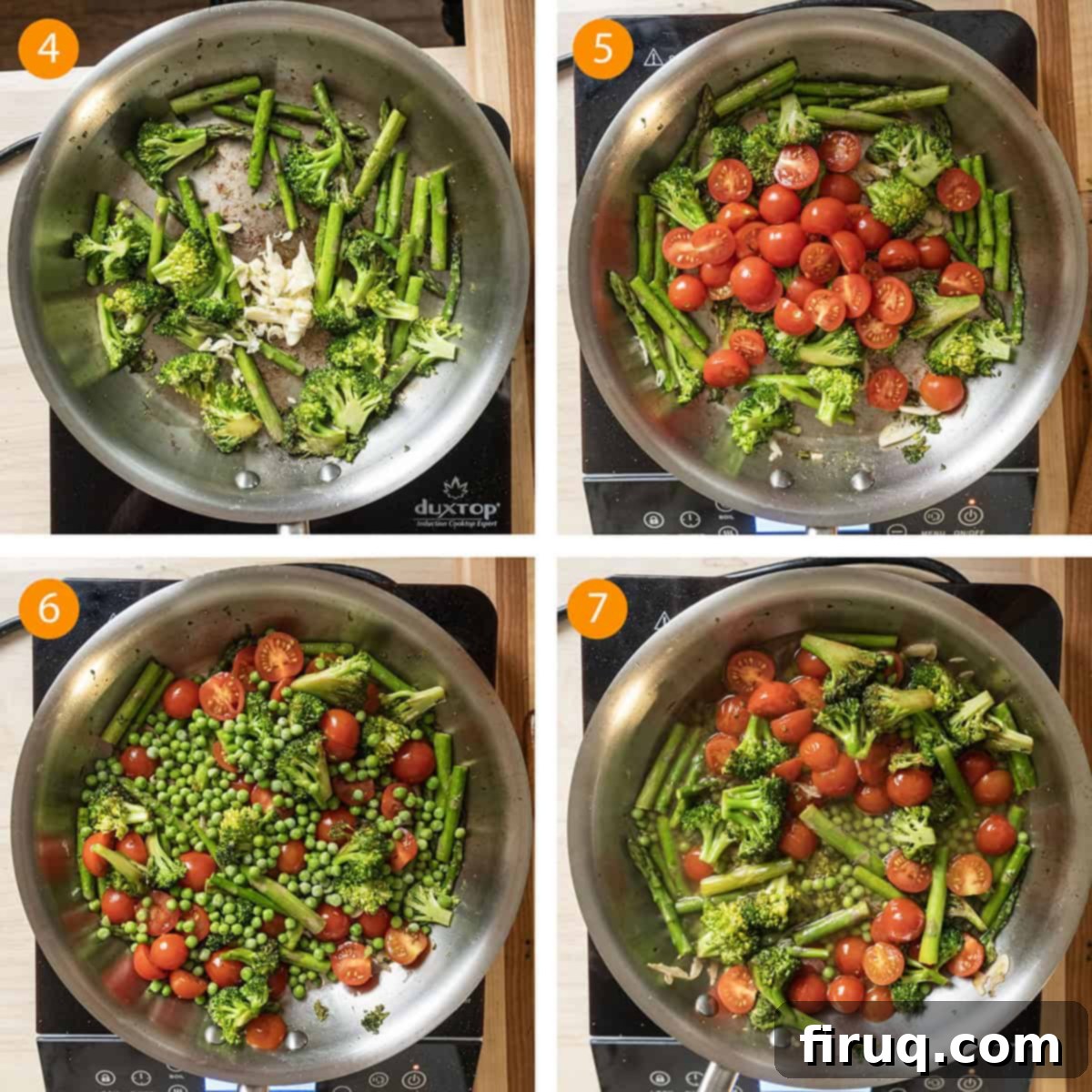
Step 4: Infuse with Garlic. Once the broccoli and asparagus are vibrant, add the minced garlic to the pan. Sauté for just 1-2 more minutes, stirring constantly, until the garlic is wonderfully fragrant. Be careful not to burn it, as burnt garlic can taste bitter.
Step 5: Soften the Tomatoes. Add the cherry tomatoes and a pinch of salt to the pan. Continue to simmer for about 5 minutes, or until the cherry tomatoes begin to soften and burst, releasing their sweet juices into the developing sauce.
Step 6: Add Peas. Stir in the frozen peas. They will warm through quickly, usually within 1-2 minutes, without needing to be cooked for a long time.
Step 7: Deglaze with White Wine. Pour in the white wine and bring it to a gentle simmer. Allow it to cook for a few minutes, scraping up any flavorful browned bits from the bottom of the pan (this is called deglazing). The alcohol will cook off, leaving behind a wonderful depth of flavor.
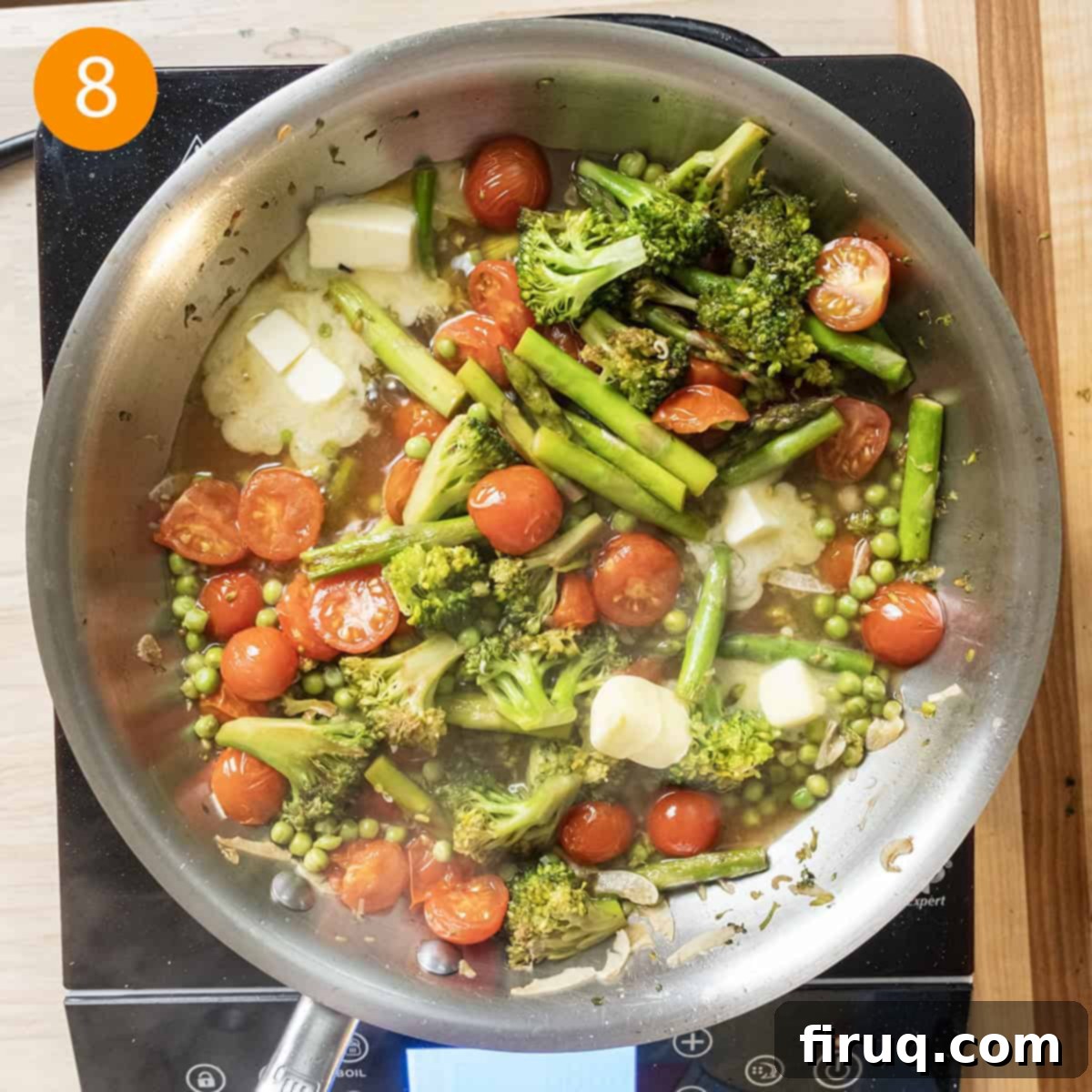
Step 8: Enrich the Sauce. Stir in the reserved pasta water and the butter. The starchy pasta water will help to emulsify the sauce, making it silky and ensuring it clings beautifully to the pasta. Continue to simmer gently until the pasta is fully cooked to al dente perfection.
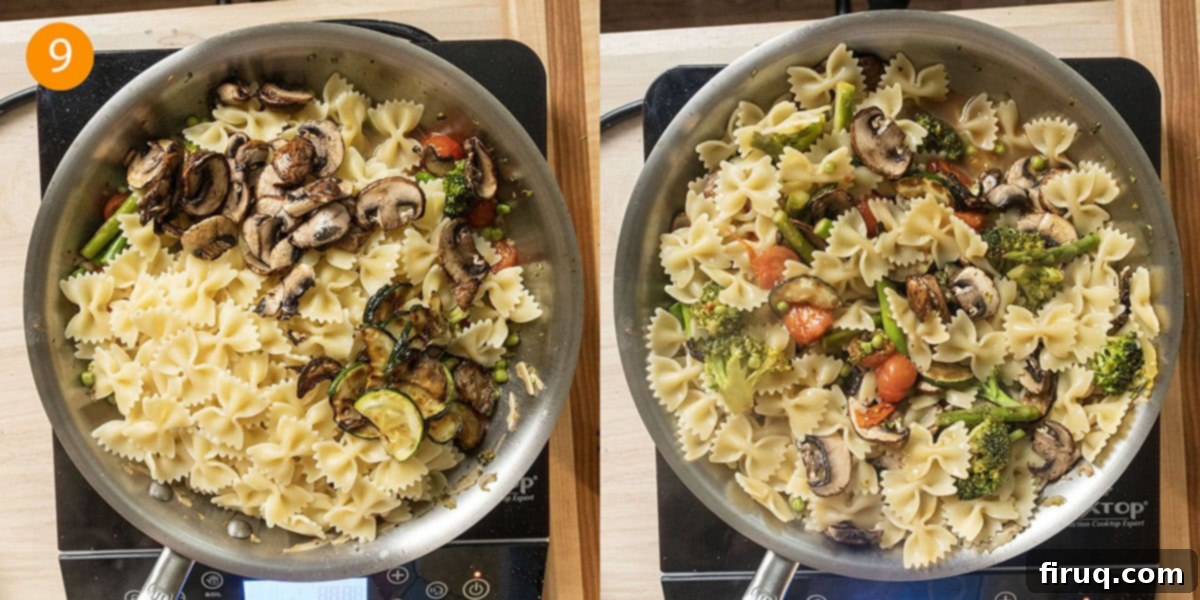
Step 9: Combine and Thicken. Once the linguine is cooked, strain it and add it directly to the pan with the simmering vegetables and sauce. Stir in the previously cooked zucchini and mushrooms until all the ingredients are well combined and the pasta is thoroughly coated with the sauce. Let the sauce simmer for a few more minutes, stirring frequently, until it begins to thicken slightly. The sauce will reach its ideal consistency just after you remove it from the heat.
Remove the pan from the heat, give it a final toss, and serve immediately. Top generous portions with freshly grated Parmesan cheese and a sprinkle of fresh herbs if desired. This Pasta Primavera with broccoli and asparagus makes a perfect light meal or an incredible side dish to complement your favorite proteins this Spring, such as savory Chicken Spiedini, hearty Grilled Stuffed Pork Chops, or even a flavorful My Big Fat Greek Chicken Burger. Enjoy the taste of spring!
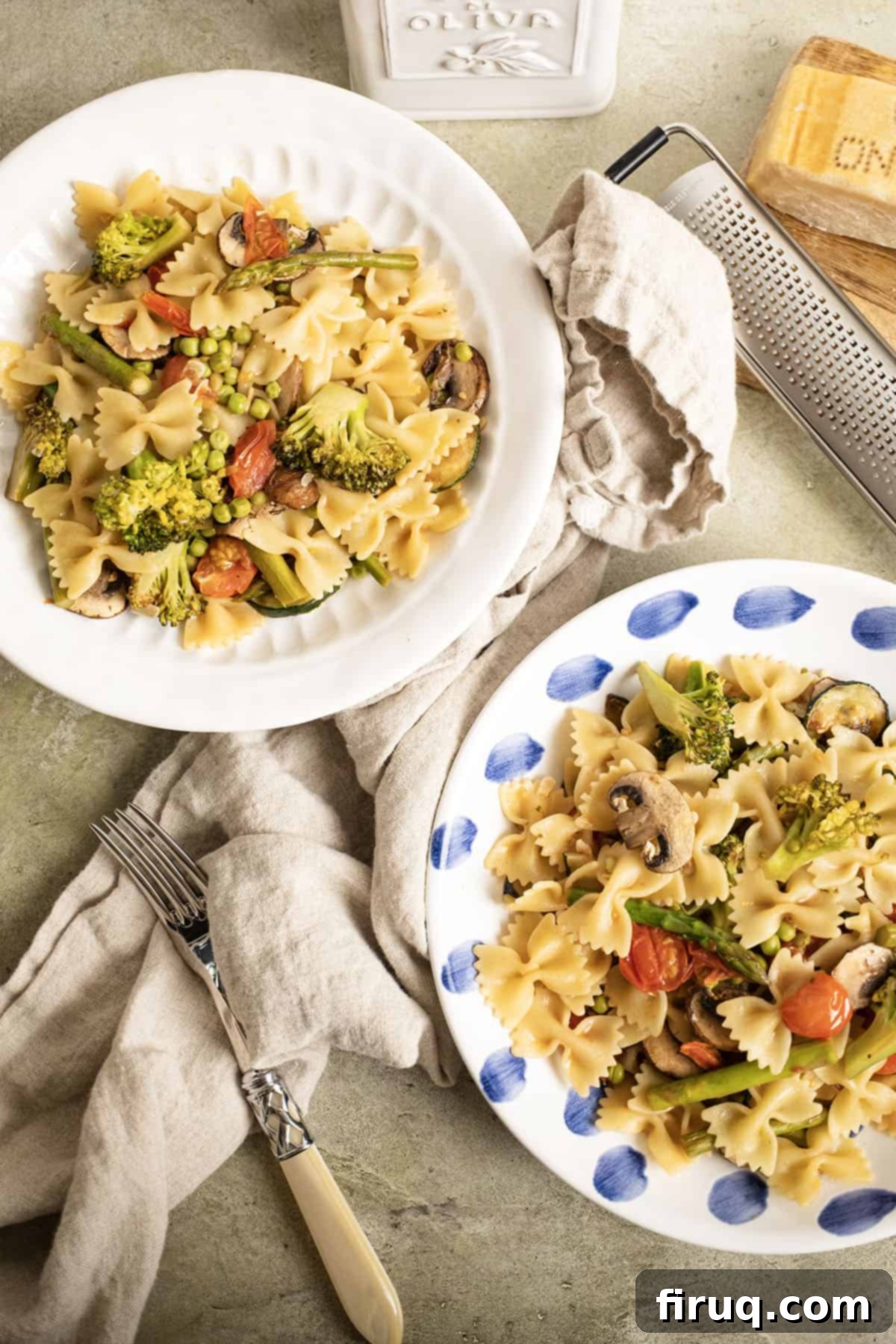
Expert Tips for a Flawless Pasta Primavera
Follow these professional tips to elevate your Pasta Primavera from good to absolutely outstanding:
- Always Use Frozen Peas: This cannot be stressed enough. Canned peas are typically overcooked and will turn into an unappetizing mush when added to your pasta. Frozen peas, on the other hand, maintain their vibrant color, sweet flavor, and satisfying pop of texture.
- Proper Broccoli Prep: Ensure your broccoli florets are chopped into small, bite-sized pieces. This allows them to cook quickly and soften to a tender-crisp consistency when sautéed, preventing them from being too hard while the other vegetables are done.
- Fry Mushrooms and Zucchini Separately: This is the golden rule for great primavera. Frying these vegetables individually from the rest of the ingredients allows them to achieve a beautiful golden-brown crust and develop deep, savory flavors. If you cook them all together, the moisture released by these water-rich vegetables will cause everything to steam rather than sear, leading to a bland, soggy texture.
- Don’t Overcrowd the Pan: When searing vegetables, especially mushrooms and zucchini, always ensure they are in a single layer without overlapping. Overcrowding lowers the pan temperature and causes vegetables to steam rather than brown, leading to poor texture and flavor. Work in batches if necessary.
- Patience with the Sauce Thickening: When you initially add the pasta to the pan, the sauce might appear a bit thin. Don’t worry! Continue to simmer and toss for a few minutes. The starches from the pasta, combined with the butter and pasta water, will work their magic. It will gradually start to thicken, reaching its perfect coating consistency just as you remove the pan from the heat.
- Taste and Adjust Seasoning: Always taste your sauce before combining it with the pasta and again just before serving. Adjust salt, pepper, and add a squeeze of fresh lemon juice or more Parmesan if needed. Proper seasoning is key to making flavors pop.
Frequently Asked Questions About Pasta Primavera
The beauty of pasta primavera lies in its flexibility! “Primavera” means “spring” in Italian, so the idea is to fill the dish with whatever seasonal vegetables are fresh and abundant. Typical spring vegetables often include asparagus, broccoli, mushrooms, zucchini, and peas. However, you can also incorporate bell peppers, snap peas, green beans, spinach, chopped carrots, or even artichoke hearts. Feel free to customize it with your favorites or whatever is best at your local market!
You absolutely *can* add cream to pasta primavera if you prefer a richer sauce, and many popular variations do. However, for a traditional and authentic primavera, a cream-based sauce is often avoided to keep the dish light and fresh, allowing the delicate flavors of the spring vegetables to shine through. A light sauce made with good quality olive oil, fresh garlic, white wine, pasta water, and a touch of butter creates enough body and flavor without the heaviness of cream. If you still crave a hint of creaminess, you can add a tablespoon or two of crème fraîche or a splash of heavy cream at the very end, just enough to enrich without overpowering.
Pasta primavera is incredibly versatile and can be enjoyed as a light main course or a vibrant side dish. In my opinion, it always shines as a fantastic side. I love to serve it with elegant proteins like Restaurant-Style Chicken Saltimbocca or Grilled Lemon Pepper Chicken Thighs. It’s also an ideal companion for spring and summer grilling events, pairing perfectly with a juicy Bacon Blue Cheeseburger or a gourmet Mushroom Gruyere Grilled Cheese. For a simpler meal, a crusty baguette and a fresh green salad are all you need.
More Delicious Vegetable-Packed Pasta Recipes
If you loved this Pasta Primavera, you’re in for a treat! Explore these other fantastic pasta dishes that celebrate fresh vegetables and incredible flavors:
- Creamy Brie Pasta
- Pasta alla Norma (A Sicilian Dish)
- Pasta with Cauliflower
- Simple Pasta with Eggplant and Tomatoes
Please leave a comment and a star rating below in the recipe card! We love to hear what you think of our recipes and how they turn out for you. Feel free to tag us on Instagram @vindelgiudice when you share your delicious creations!
📖 Recipe
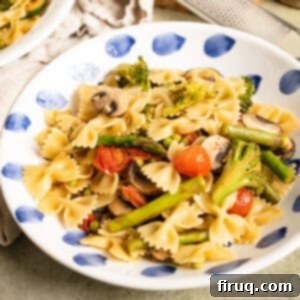
Pasta Primavera with Broccoli and Asparagus
Vincent DelGiudice
Pin Recipe
Equipment
-
1 large saucepan
-
1 large pot
Ingredients
- ½ lb linguine
- 6 oz baby bella mushrooms, sliced
- 1 small zucchini, sliced and halved
- ½ cup frozen peas
- 1 head broccoli chopped into florets
- 1 bunch asparagus, chopped in thirds
- 3 cloves garlic, minced
- 1 cup cherry tomatoes
- ⅔ cup white wine (e.g., Sauvignon Blanc or Pinot Grigio)
- ½ cup pasta water (reserved from cooking linguine)
- 4 tablespoon extra virgin olive oil
- 1 teaspoon salt (plus more for pasta water)
- 2 tablespoon unsalted butter
- Parmesan cheese, for serving
Instructions
-
Heat a large saucepan or skillet to medium heat. Add your sliced baby bella mushrooms in a single layer. Let them sit undisturbed for 3 minutes, then stir. Continue to brown the mushrooms for 3-5 more minutes until deeply golden. Remove them from the pan and set them aside.
-
Add 2 tablespoons of olive oil to the same pan. Add the zucchini slices in a single layer. Fry for 2-3 minutes on each side or until golden brown. Remove them and set them aside with the mushrooms.
-
In a large pot, bring generously salted water to a rolling boil. Add the linguine and cook until just before al dente (about 1 minute less than package directions). Before draining, reserve 1 cup of the starchy pasta water.
-
In the same saucepan (where you cooked the mushrooms and zucchini), add the remaining 2 tablespoons of olive oil. Toss in the broccoli florets and asparagus pieces and sauté for 5 minutes, or until they are vibrant green and tender-crisp. Then, add the minced garlic and sauté for 1-2 more minutes until the garlic is fragrant and lightly golden (be careful not to burn it).
-
Add the cherry tomatoes and the teaspoon of salt. Simmer for 5 minutes until the cherry tomatoes begin to soften and release their juices. Stir in the frozen peas until they are warmed through, about 1-2 minutes. Pour in the white wine and bring to a simmer, cooking for 5 minutes to allow the alcohol to cook off and the flavors to meld. Finally, add the reserved pasta water and butter, simmering for 2-3 minutes to begin forming the sauce.
-
Strain the linguine and add it directly to the pan with the simmering vegetables and sauce. Add back the sautéed zucchini and mushrooms. Toss everything together until the pasta is well combined and thoroughly coated with the sauce. Let the sauce simmer for a few more minutes, stirring frequently, until it begins to thicken slightly and clings beautifully to the pasta.
-
Remove the pan from the heat. Serve the Pasta Primavera immediately, topped with freshly grated Parmesan cheese and a sprinkle of fresh parsley or basil if desired.
Notes
- Always use frozen peas for the best texture and flavor. Canned peas will immediately turn to mush.
- Ensure the broccoli florets are chopped into small, bite-sized pieces so they soften adequately when sautéed.
- Frying mushrooms and zucchini separately from the rest of the dish is crucial. This technique allows them to brown beautifully and prevents the entire dish from becoming watery or mushy.
- When you first add the cooked pasta to the pan, the sauce might appear thin. Continue to simmer and toss for a few minutes; the starches from the pasta water will help it thicken and emulsify, reaching the perfect coating consistency once removed from the heat.
- For a touch of extra brightness, finish with a squeeze of fresh lemon juice just before serving.
Nutrition
